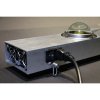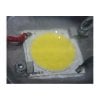You are using an out of date browser. It may not display this or other websites correctly.
You should upgrade or use an alternative browser.
You should upgrade or use an alternative browser.
LED Companies w/ LINKS
- Thread starter Beefbisquit
- Start date
guod
Well-Known Member
Ramp-3x70W-210w led hydroponics
COB LED 200 W ramp online 3x70 W, CREE LED CXA 3070 under lens
27,400 lumen temperature - white choice:
2700 ° K - 3000 ° K - 3500 ° K - 4000 ° K - 5000 ° K - 5700 ° K - 6500 ° K
Use: Grow plant, professional lighting.
MEAN WELL Power 200 W - 240 volts integrated in the aluminum-section comes with 3 m cable
2 cooling fans 19m3 / h, 27dB
VMC connection option on 80 mm diameter with removal of fans.
3x90 ° lighting angle spacing diodes: 56 cm
Aluminium dimension 1443 * 110 * 65mm weight 6300 g
Brushed aluminum finish; thermo lacquered paint on option

in french...
http://www.eclairage-led-relamping....te/140-rampe-led-210w-3x70w-hydroponique.html
COB LED 200 W ramp online 3x70 W, CREE LED CXA 3070 under lens
27,400 lumen temperature - white choice:
2700 ° K - 3000 ° K - 3500 ° K - 4000 ° K - 5000 ° K - 5700 ° K - 6500 ° K
Use: Grow plant, professional lighting.
MEAN WELL Power 200 W - 240 volts integrated in the aluminum-section comes with 3 m cable
2 cooling fans 19m3 / h, 27dB
VMC connection option on 80 mm diameter with removal of fans.
3x90 ° lighting angle spacing diodes: 56 cm
Aluminium dimension 1443 * 110 * 65mm weight 6300 g
Brushed aluminum finish; thermo lacquered paint on option

in french...
http://www.eclairage-led-relamping....te/140-rampe-led-210w-3x70w-hydroponique.html
Attachments
PSUAGRO.
Well-Known Member
Grow Northern / Dutch Passion will be back...
pics and all in two weeks as ever...!o! .. iynwim
- Philips Rebel chips as standard
- 75W - virtually silent
- 220-240v only.
- £330 in VAT.
Killer option
Ramp-3x70W-210w led hydroponics
COB LED 200 W ramp online 3x70 W, CREE LED CXA 3070 under lens
27,400 lumen temperature - white choice:
2700 ° K - 3000 ° K - 3500 ° K - 4000 ° K - 5000 ° K - 5700 ° K - 6500 ° K
Use: Grow plant, professional lighting.
MEAN WELL Power 200 W - 240 volts integrated in the aluminum-section comes with 3 m cable
2 cooling fans 19m3 / h, 27dB
VMC connection option on 80 mm diameter with removal of fans.
3x90 ° lighting angle spacing diodes: 56 cm
Aluminium dimension 1443 * 110 * 65mm weight 6300 g
Brushed aluminum finish; thermo lacquered paint on option
View attachment 3286957
in french...
http://www.eclairage-led-relamping....te/140-rampe-led-210w-3x70w-hydroponique.html
Killer price

doctorflux
Well-Known Member
Grow Northern / Dutch Passion will be back...
pics and all in two weeks as ever...!o! .. iynwim
- Philips Rebel chips as standard
- 75W - virtually silent
- 220-240v only.
- £330 in VAT.
Is anyone concerned about the fact that these Philips Rebel boards are not well designed:
http://grownorthern.co.uk/index.php/online-store/category-3
Putting all of these LEDs of various forward voltages in series will not result in equal or even optimal current control. The board doesn't have any components which would regulate the current across the different LEDs (such as a few transistors for a current mirror). The Philips Rebel packages have forward voltages that range from 2.3V-3.1V at operating temperature, and the Everlight LEDs have a Vf of only 2V.
This practice seems to be the case with most of the low quality multi-band LED lights on the market. Is anyone aware of this or even care?
guod
Well-Known Member
Last edited:
Dloomis514
Well-Known Member
I get an invalid page on that link iukwim^^^^^^^^^^^^^^
Maybe this will help
Positivity
Well-Known Member
Is anyone concerned about the fact that these Philips Rebel boards are not well designed:
http://grownorthern.co.uk/index.php/online-store/category-3
Putting all of these LEDs of various forward voltages in series will not result in equal or even optimal current control. The board doesn't have any components which would regulate the current across the different LEDs (such as a few transistors for a current mirror). The Philips Rebel packages have forward voltages that range from 2.3V-3.1V at operating temperature, and the Everlight LEDs have a Vf of only 2V.
This practice seems to be the case with most of the low quality multi-band LED lights on the market. Is anyone aware of this or even care?
That's the second post I've seen recently saying different forward voltages can't be used on the same driver.
I remember hearing that a lot in the past. I asked questions...no one would answer. So I tested it out myself. And guess what....

I call bullshit.
Last edited:
Greengenes707
Well-Known Member
In here...guod chimes in on page 2I get an invalid page on that link iukwim
https://www.rollitup.org/t/need-a-good-cob.849804/
Never realized you had them all on the same driver(s).That's the second post I've seen saying different forward voltages can't be used on the same driver.
I remember hearing that a lot in the past. I asked questions...no one would answer. So I tested it out myself. And guess what....
I call bullshit.
Are they all series? or did you have to parallel the monos somehow?
Positivity
Well-Known Member
Never realized you had them all on the same driver(s).
Are they all series? or did you have to parallel the monos somehow?
All in series at 1a. My XML light is a big mixup of LEDs at 700ma on the red channel. That light is still running a year later with no problems.
I missed that post by guod. That's a very cool way to drop the current on the smaller leds.
epicfail
Well-Known Member
That's the second post I've seen saying different forward voltages can't be used on the same driver.
I remember hearing that a lot in the past. I asked questions...no one would answer. So I tested it out myself. And guess what....
View attachment 3287214
I call bullshit.
@FranJan threw me off today when he said he didn't know that either and he has already built a few lights, these are the basic or electricity. Individual stars or chips inside of a COB are going to use different voltages, even if its just a little. Not all CXA3070 draw the same voltage neither.
Positivity
Well-Known Member
That's the answer I was looking for...I figured current going in was current going out..
Kirchoffs First Law – The Current Law, (KCL)
Kirchoffs Current Law or KCL, states that the “total current or charge entering a junction or node is exactly equal to the charge leaving the node as it has no other place to go except to leave, as no charge is lost within the node“. In other words the algebraic sum of ALL the currents entering and leaving a node must be equal to zero, I(exiting) + I(entering) = 0. This idea by Kirchoff is commonly known as the Conservation of Charge.
The "you can't run different LEDs with different forward voltages on the same series circuit" debunked.
Kirchoffs First Law – The Current Law, (KCL)
Kirchoffs Current Law or KCL, states that the “total current or charge entering a junction or node is exactly equal to the charge leaving the node as it has no other place to go except to leave, as no charge is lost within the node“. In other words the algebraic sum of ALL the currents entering and leaving a node must be equal to zero, I(exiting) + I(entering) = 0. This idea by Kirchoff is commonly known as the Conservation of Charge.
The "you can't run different LEDs with different forward voltages on the same series circuit" debunked.
FranJan
Well-Known Member
y
 .
.
No, no what I didn't understand was the behavior of drivers, that you can fudge the circuit to make sure a driver will work in certain circumstances. Different forward voltages I knew were OK from repairing my Blackstars which have blue red white UV and FR of different Vfs all in one string. I even just said something to that effect just a week or so ago to another poster who said you can't run LEDs with different voltages in the same string. Church just threw me in another thread and made me realize that I wasn't looking at the circuit the proper way. Sometimes my laziness gets the best of me and I stop thinking things through when I get the answer I want . Yup Ima human@FranJan threw me off today when he said he didn't know that either and he has already built a few lights, these are the basic or electricity. Individual stars or chips inside of a COB are going to use different voltages, even if its just a little. Not all CXA3070 draw the same voltage neither.
doctorflux
Well-Known Member
The "you can't run different LEDs with different forward voltages on the same series circuit" debunked.
I agree - I was under the impression that the variation in forward voltage drop at different temperatures between InGaN and AlInGaP LEDs was significantly different. Checking some datasheets I can see that this was a long held misconception on my part. Perhaps I read too many reference designs from LED driver IC manufacturers...
Positivity
Well-Known Member
I agree - I was under the impression that the variation in forward voltage drop at different temperatures between InGaN and AlInGaP LEDs was significantly different. Checking some datasheets I can see that this was a long held misconception on my part. Perhaps I read too many reference designs from LED driver IC manufacturers...
Cool...sorry if I come off brash. I've had issues trying to get my lights built right and topics such as this were always causing confusion.
The Cree CXA 3070 at 1a consumes roughly 38v. The Olson in my picture are at 2.8v. They have a larger difference then I've ever seen run and have been problem free.
Cococola36
Well-Known Member
I'm prepared to get roasted for this haha, due to laziness and the fact that it is in fact sleezbay but are these worth it all for a non diy guy like myself??
http://www.ebay.com/itm/3pcs-21W-CR...3408806?pt=US_Light_Bulbs&hash=item566c4156a6
http://www.ebay.com/itm/3pcs-21W-CR...3408806?pt=US_Light_Bulbs&hash=item566c4156a6
hyroot
Well-Known Member
I'm prepared to get roasted for this haha, due to laziness and the fact that it is in fact sleezbay but are these worth it all for a non diy guy like myself??
http://www.ebay.com/itm/3pcs-21W-CR...3408806?pt=US_Light_Bulbs&hash=item566c4156a6
its based in china though. So warranty ......
 . It may not really be cree. The seller has 1668 negatives.
. It may not really be cree. The seller has 1668 negatives.Cococola36
Well-Known Member
Yea that name going across the pic def made me think china, which doesn't ALWAYS scare me but anywho, out of almost 300,000 sales i tried to see the upside lol. Plus i realized i would need like 25 of them to accomplish my goal sooo yea theres that...its based in china though. So warranty ....... It may not really be cree. The seller has 1668 negatives.
FranJan
Well-Known Member
OK all you Cobsters out there it's time for some interesting news in Mono-Land! Some people out there may want to start thinking about dumping your phosphor stocks 
 .
.

06.11.2014
Green Gap phenomenon
Description: LEDs show a significant efficacy drop in the green spectral range – an effect known as the “green gap” phenomenon.
http://beamlog.blogspot.se/2013/10/osram-addresses-led-green-gap.html?m=1
"Ever heard of the “Green Gap” in LEDs? This is the wavelength band that covers the range from about 520nm – 635nm where there is no commercially available semiconductor material that can be used to make efficient LEDs. Unfortunately, the optimum green LED primary for display applications, 540nm and the optimum red display primary, 622nm, both fall in this gap. While it is called the “Green Gap,” the gap actually covers green, yellow and orange wavelengths."
Still believe in that "Full Spectrum" shit kiddies? LOL
LOL
Osram LEDs Achieve Record-Breaking Efficacies in Green Spectral Range
http://www.tmcnet.com/usubmit/-osra...cacies-green-spectral-/2014/11/06/8108119.htm
(PR Web Via Acquire Media NewsEdge) Sunnyvale, CA (PRWEB)
http://www.tmcnet.com/usubmit/-osra...cacies-green-spectral-/2014/11/06/8108119.htm
(PR Web Via Acquire Media NewsEdge) Sunnyvale, CA (PRWEB)
November 06, 2014 The "Hi-Q-LED" project funded by Germany's Federal Ministry of Education and Research (BMBF) has made pioneering advances with green LEDs, greatly diminishing what is known as the "green gap" phenomenon – the significant drop in efficacy in the green spectral range. The result is a green-emitting LED based on indium gallium nitride (InGaN) semiconductors that achieves a record efficacy of 147 lumens per watt (lm/W) at a wavelength of 530 nanometers (nm) and a spectral width of 35 nm. In addition, another green LED developed by combining a blue chip with a phosphor converter has achieved a record-breaking efficacy exceeding 200 lm/W.
Green all-InGaN LEDs close the "green gap" Conventional LEDs show a significant efficacy drop at wavelengths above 500 nm – a phenomenon known as the "green gap". Research activities in the framework of the project have enabled the development of a narrowband green LED with a record efficacy of 147 lm/W for a chip size of 1 mm2 and a driving current of 350 mA (current density: 45 A/cm2). The LED has a central wavelength of 530 nm and a forward voltage of 2.93 volts (V) at this current density. A reduction of the carrier density in the light-emitting layers and a significantly improved material quality were the key factors behind this breakthrough. Thanks to a significantly reduced dependency of the efficacy on the operating current compared to conventional green LEDs, the LED prototype shows significantly improved performance at higher current densities and achieves as much as 338 lumen (lm) at 125 A/cm2. "InGaN-based LEDs, in which the light output is generated by an InGaN semiconductor exclusively, offer a much more narrowband emission with a spectral width of approximately 35 nm compared to green LEDs that are based on phosphor conversion," explained Dr. Andreas Löffler, Project Manager at Osram Opto Semiconductors. "This breakthrough is an enabling technology for highly efficient projection systems requiring a high color rendering index. After all, a high color rendering index or an increased color gamut means a more vivid, higher-quality image." Record-breaking efficacy of >200 lm/W achieved with a green full conversion phosphor solution The second approach of the project, which was to create a new, even more efficient green LED, comes into play in cases where the spectral bandwidth of the LED is not critical. Record-breaking figures demonstrated were 209 lm/W (210 lm) with a chip size of 1mm2, a central wavelength of 540 nm, a forward voltage of 2.88 V and a driving current of 350 mA (current density: 45 A/cm²). For a current density of 125 A/cm2, it proved possible to increase the light output to above 500 lm. Despite this high current density, the efficacy of these devices reaches 160 lm/W. The efficacy peaks at 1.5 A/cm² with a maximum of 274 lm/W. According to Osram research engineer Dr. Thomas Lehnhardt, these exceptional performance figures have been achieved thanks to the optimized interaction of chip and converter technologies. "Continuous improvement of the blue LED chips, an optimized excitation wavelength and an increased degree of conversion of the phosphor converter are the winning combination underlying this new record-breaking LED," he explained.

06.11.2014
Green Gap phenomenon
Description: LEDs show a significant efficacy drop in the green spectral range – an effect known as the “green gap” phenomenon.
Here's why abolishing the green gap is good for growers IMO.http://beamlog.blogspot.se/2013/10/osram-addresses-led-green-gap.html?m=1
"Ever heard of the “Green Gap” in LEDs? This is the wavelength band that covers the range from about 520nm – 635nm where there is no commercially available semiconductor material that can be used to make efficient LEDs. Unfortunately, the optimum green LED primary for display applications, 540nm and the optimum red display primary, 622nm, both fall in this gap. While it is called the “Green Gap,” the gap actually covers green, yellow and orange wavelengths."
Still believe in that "Full Spectrum" shit kiddies?
Swiller
Well-Known Member
"Still believe in that "Full Spectrum" shit kiddies?  LOL"
LOL"
I do. I am not saying you cannot grow cannabis under a few specific spectrum's, but after a few billion years of growing under the full spectrum of the sun, there are unknown variables that cannot be tested for so quickly.
All that being said, bring on the LED efficiencies!
I do. I am not saying you cannot grow cannabis under a few specific spectrum's, but after a few billion years of growing under the full spectrum of the sun, there are unknown variables that cannot be tested for so quickly.
All that being said, bring on the LED efficiencies!
Similar threads
- Replies
- 0
- Views
- 411
- Replies
- 7
- Views
- 867
- Replies
- 0
- Views
- 423



